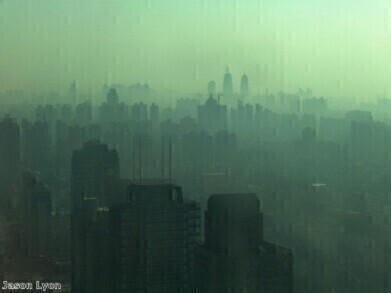Air quality monitoring
The week that New York had the worst air quality in the world
Jun 15 2023
New York City is as much a set of world-famous icons as it is a city: the City That Never Sleeps. Moreover, it is world-renowned in a variety of fields, from finance and tech to medicine and the arts. But for one week in June, it topped global charts for another reason – and this time, it’s hardly an advertisement for the City.
Last week, the city’s air quality index (AQI), an integrated measure of various pollutants, peaked over 400 out of a possible 500. An ordinary weekend reading, in comparison, lingers around 30. Just 24 hours after reaching apocalyptic levels, the AQI receded to 160, still alarmingly high but a slight reprieve. The perpetrator was a fugitive smoke cloud from distant Canadian wildfires that had descended upon the East Coast, transforming the clear blue into a pall of smoky yellow.
The subterranean life of New York was not spared either. Researchers from New York University recorded PM2.5 particulate matter levels at subway stations that significantly exceeded typical readings. A usual day might register about 12 micrograms of particles per cubic meter of air; on that ominous June 7, the Broadway-Lafayette station in Manhattan registered a staggering 660.
These astronomical figures measured particulate matter alone. In contrast, the AQI encompasses both particulate matter and ozone among other pollutants, painting a more holistic, albeit grave, picture.
Recent studies highlight the acute vulnerability of the subway network to such hazardous air, with stations near underwater tunnels particularly prone to high levels of pollution. This river-tunnel effect was exacerbated by the week-long deluge of wildfire smoke, making the subway system a particularly hazardous environment. Other studies indicated that some subway sections experienced air contamination levels comparable to wildfire sites and demolition zones.
The health impacts were immediately evident, with emergency room visits for respiratory ailments skyrocketing on June 7. The city's Health Department recorded 309 ER visits for asthma and related symptoms, a significant jump from the average of 135 to 200 visits.
Political leaders faced mounting criticism for their response to the crisis. New York City Mayor Eric Adams faced backlash for the city's apparent unpreparedness for the situation, despite precedence set by California and federal guidelines for managing such conditions. Controversially, his proposal to dilute the right-to-shelter mandate while urging residents to stay indoors did not sit well with many.
Yet, the crisis put the broader problem into perspective. The city's struggle underscored the accelerating effects of climate change and the gap between our preparedness and the rapidly worsening environmental conditions.
In a bid to alleviate the situation, Governor Kathy Hochul declared that one million N95-style masks would be freely distributed at public centers and transport hubs across the city. The Metropolitan Transportation Authority (MTA), which had initiated a pilot project for improved air filtration systems in 2020, stepped up their efforts, albeit in a limited capacity.
The effects of the smoke were not only respiratory but also had a strange olfactory and gustatory impact. According to Kathryn Medler, a taste expert at the University at Buffalo, many New Yorkers experienced an odd "mouldy cigar-like" taste, likely the result of smoke particles lingering in their mouths.
The origin of the calamity lay hundreds of miles away in Canada, where hundreds of forest fires had set ablaze about 3.8 million hectares of land - approximately 15 times the average. The resultant smoke cloud stretched far south, engulfing New York City and resulting in the cancellation of flights, closure of tourist attractions, and an orange smog overlaying iconic landmarks like Times Square.
The wildfires, ignited by a mix of lightning strikes and human activity, found fertile ground due to unusually low snow due to cover and high temperatures in the spring. These conditions, partly attributed to climate change, exacerbated the wildfires' intensity and longevity, enabling the smog to reach unprecedented territories like New York.
When the fog of smog finally lifted from New York, life was far from returning to normal. The crisis had opened a new front in the ongoing conversation about climate change, urban planning, and public health. The week-long event underscored the interconnectedness of climate phenomena and the global nature of environmental challenges.
Residents, government, and researchers are now grappling with the long-term consequences of this exposure. The immediate health crisis might have passed, but the aftermath has thrown into sharp relief the urgent need for preventative action. An increasing number of researchers and environmental activists are stressing the importance of predictive modelling, early warning systems, and resilient urban planning to protect residents' health in future similar occurrences.
While New York recuperates, the event serves as a harsh reminder of climate change's tangible effects. The week New York became the world's smog capital is a chilling testament to a changing world. The impacts of climate change aren't a distant future problem, but a present reality that we must face head-on, armed with science, informed policy, and collective global action.
Digital Edition
IET 35.2 March
April 2025
Air Monitoring - Probe Sampling in Hazardous Areas Under Extreme Conditions - New, Game-Changing Sensor for Methane Emissions - Blue Sky Thinking: a 50-year Retrospective on Technological Prog...
View all digital editions
Events
Apr 21 2025 Shanghai, China
Apr 22 2025 Hammamet, Tunisia
Apr 22 2025 Kintex, South Korea
Analytica Anacon India & IndiaLabExpo
Apr 23 2025 Mumbai, India
Apr 23 2025 Moscow, Russia

.jpg)

















